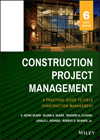'Build Chain' Links Project Success
 |
| BURNS |
It took the events of Sept. 11, 2001, and a 300% increase in construction to support the war on terrorism for me to look at the project delivery process in a new way. That increase was on a $500-million existing construction program I inherited that was over budget and over schedule. So I seriously needed to improve our process and better partner with architectural, engineering and construction firms to face those challenges. The key was looking at project delivery as interlinked steps, realizing each step influences the success or failure of the next.
At an airport last year, I drew a circle on a napkin, then started to redefine the steps in our project delivery process, as I knew them. When I had them drawn out, a blinding glimpse of the obvious hit me: The more the steps were interlinked, the next step wouldnt just be better, the end product also would be better.
The first step of my Build Chain concept is to visualize what it is you want to build. For most architects and engineers, thats not easy to do. But for many clients, owners and closet engineers, it is more difficult than it should be.
Fortunately, 3D virtual engineering tools solve that problem, letting clients and designers share the same vision. The $10,000 to $15,000 spent on 3D visualization early in the project can preclude $100,000 to $150,000 in construction changes later on. So conceptualize became the second step, with 3D virtual engineering providing the key link.
Plan is the third step. It considers basic site constraints, preliminary size and scope of the project, cost limits and need date. By imbedding the 3D virtual engineered concept in geospatial imagery, the concept and plan are properly interlinked.
The fourth step is critical in the military and for private owners program the necessary funding. The military plans major project funding almost two years out, which makes accurate cost estimating and scope control critical.
To link the 3D plan through the program process, weve adopted a customer concept document. It essentially is a 35% design a year early, ensuring the clients requirements are codified and the cost estimate has thorough definition.
The A-E firms out there are wondering, "When are we going to get to design this project?" The answer is now, in the fifth step, design. The CCD and 3D model strongly lead into the design part of the process. And 3D visualization tools allow enhancements like de-conflicting construction phasing or meeting historic preservation criteria.
Best Value
The easiest improvement I made to a step in the project delivery process was in the sixth step, award a contract. For too long, owners, including the military, focused on the lowest bidder. What about experience, track record, quality and timelines? Fortunately, we were able to adopt best-value award criteria. It didnt take long to realize that awarding to a great-quality, fourth-low bidder might result in a project delivered as we expected, on time and at less cost than the low bidder who added claims to the work later on.
Now were getting down to the wire. The seventh step is construct, only within tighter controls of cost and schedule. Prior military goals allowed no more than 10% schedule growth and 5% for costs. Why have such goals?
That cost growth on our $1.5-billion annual program is a lot of money. Zero is our new goal, as well as a 30 to 40% cut in schedule so builders would put their "A Teams" on our jobs.
OK, now the eighth step, deliver. The key part of this link is what we call the "red zone" process. Its tough to get all the right things done in the last 90 days before completion. So we came up with a concept to focus on finishing the project right.
There you have it. This isnt rocket science. The idea is to re-focus the project delivery process across every step so as to leverage opportunities to successfully deliver 99% of the quality, schedule, and cost that the client visualized while the firms involved make enough profit to do even better.



